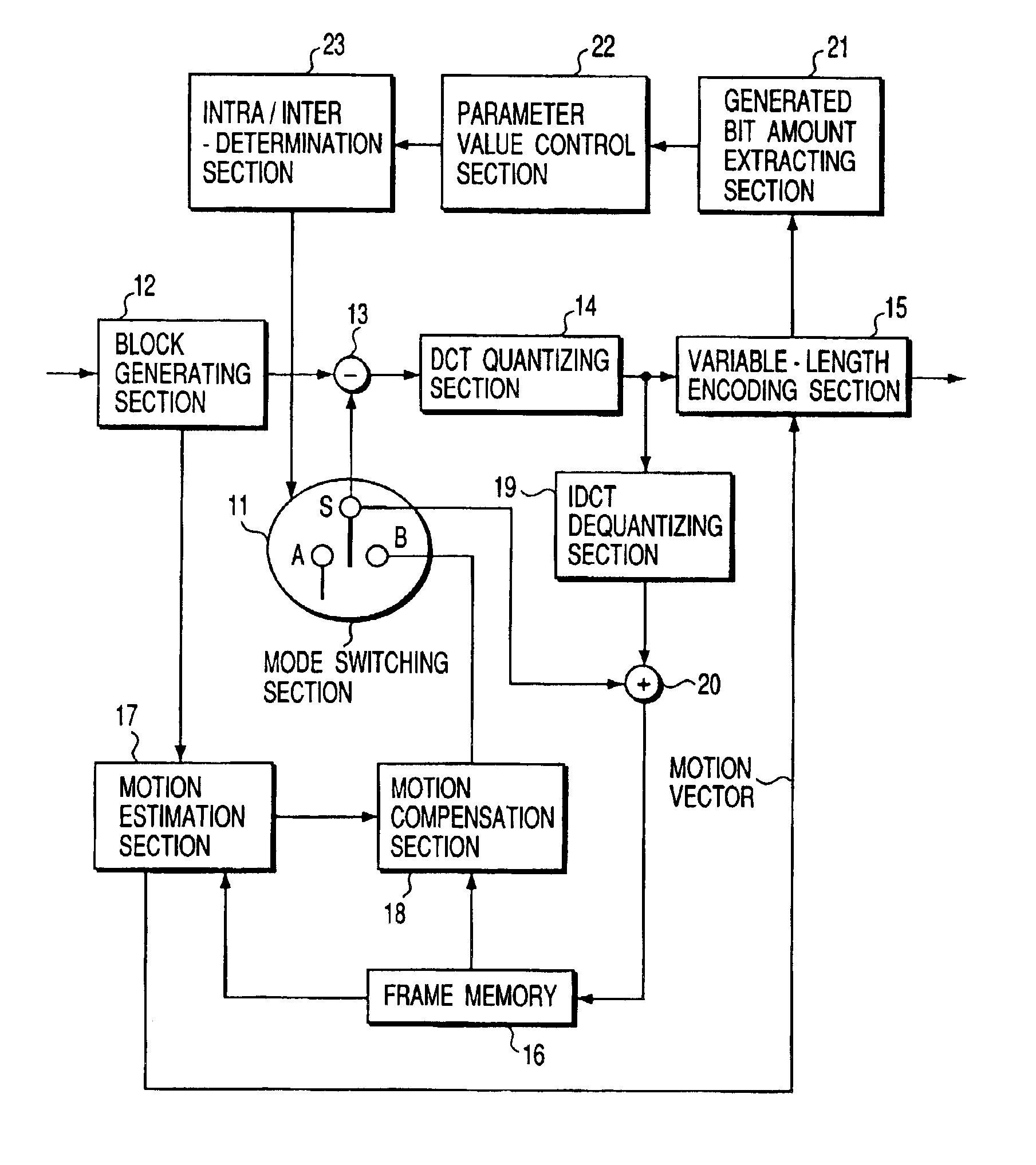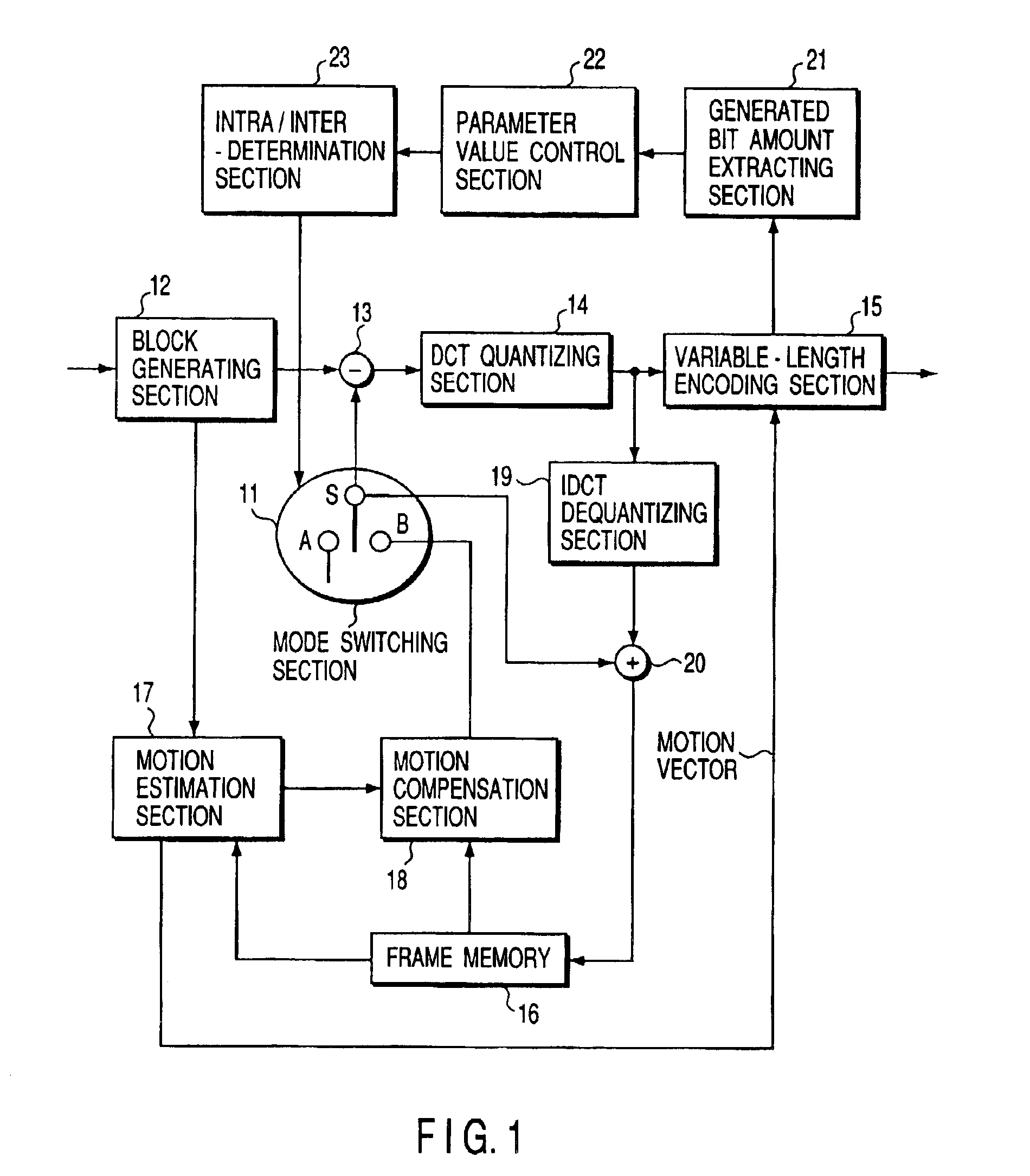Moving image encoding apparatus
a moving image and encoding technology, applied in the direction of color television with bandwidth reduction, signal generator with optical-mechanical scanning, television systems, etc., can solve the problems of data error diffused, residual deterioration in image quality gradually increasing, etc., to prevent data error diffuse, accurate determine the necessity of refresh, and prevent deterioration in image quality
- Summary
- Abstract
- Description
- Claims
- Application Information
AI Technical Summary
Benefits of technology
Problems solved by technology
Method used
Image
Examples
first embodiment
[0048]FIG. 1 is a block diagram showing the arrangement of a moving image encoding apparatus according to the first embodiment of the present invention.
[0049]A moving image encoding apparatus according to the first embodiment is characterized in that the number of encoded bits generated by variable-length-encoding data obtained by DCT coefficient quantization are monitored in units of macroblocks, thereby choosing between intra-encoding and inter-encoding for macroblocks to be processed in the next frame. More specifically, if the amount of encoded data generated by variable length encoding is large, it is determined that a large variation is occurring in the input image. In accordance with this determination, the number of bits of encoded data is counted. More specifically, if the amount of encoded data generated by variable length encoding is large, it is determined that a large variation is occurring in the input image. In accordance with this determination, the number of bits of...
second embodiment
[0079]FIG. 4 is a block diagram showing the arrangement of a moving image encoding apparatus according to the second embodiment of the present invention.
[0080]The moving image encoding apparatus of the second embodiment is characterized in that whether to intra-encode macroblocks in the next frame or inter-encode them is selected by monitoring whether a non-zero coefficient amount obtained by a DCT-quantizing section 14 is large or small in units of macroblocks. If the number of non-zero coefficients of the DCT coefficients obtained by DCT computation is large, it can be determined that a large variation is occurring in the input image. By using this, non-zero coefficients are counted, and it is determined in accordance with this count value whether to perform refresh operation or not.
[0081]The moving image encoding apparatus shown in FIG. 4 is comprised of a mode switching section 11, a block generating section 12, a subtracter 13, the DCT-quantizing section 14, a variable-length e...
third embodiment
[0091]FIG. 6 is a block diagram showing the arrangement of a moving image encoding apparatus according to the third embodiment of the present invention.
[0092]The moving image encoding apparatus according to the third embodiment is characterized in that both or one of an update condition for a parameter value T(n) and a criterion for the selection of intra / inter-encoding is updated in accordance with an error rate in a transmission path.
[0093]Referring to FIG. 6, the moving image encoding apparatus is comprised of a mode switching section 11, block generating section 12, subtracter 13, DCT-quantizing section 14, variable-length encoding section 15, frame memory 16, motion estimation section 17, motion compensation section 18, IDCT-dequantizing section 19, adder 20, parameter value control section 22, intra / inter determination section 23, total coefficient count extracting section 24, and error rate detecting section 25. The functional blocks denoted by the same reference numerals as ...
PUM
 Login to View More
Login to View More Abstract
Description
Claims
Application Information
 Login to View More
Login to View More - R&D
- Intellectual Property
- Life Sciences
- Materials
- Tech Scout
- Unparalleled Data Quality
- Higher Quality Content
- 60% Fewer Hallucinations
Browse by: Latest US Patents, China's latest patents, Technical Efficacy Thesaurus, Application Domain, Technology Topic, Popular Technical Reports.
© 2025 PatSnap. All rights reserved.Legal|Privacy policy|Modern Slavery Act Transparency Statement|Sitemap|About US| Contact US: help@patsnap.com



